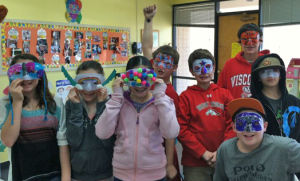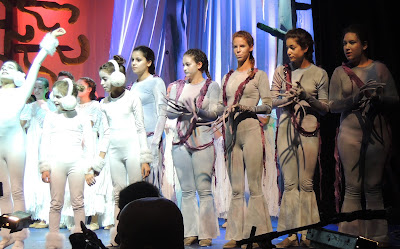Twinning program
Students in April Goodman’s sixth-grade class at Temple Solel exchanged Purim masks with students in Kiryat Malachi, Israel as part of a twinning program.Photo by April Goodman
A program that aims to connect Phoenix students with Israeli students identifies the similarities that children in both countries share — even something as simple as being fans of Superman.Two local religious schools — the Raker Religious School at Temple Solel in Paradise Valley and the Mark L. Haberkorn Religious School at Congregation Beth Israel in Scottsdale — are participating in this “twinning” program piloted by the Israel Center that uses technology to connect students in the two countries. The program is part of the Israel Center’s Partnership2gether (formerly TIPS) program, which aims to strengthen ties between the Israeli communities of Hof Ashkelon and Kiryat Malachi and the U.S. Jewish communities in Tucson, Phoenix and Seattle. Shahar Edry, the new director of the Israel Center, has said that although the program had a slow start, it has come together and they hope to expand to four religious schools in the coming school year.
“We try to build values and relationships between the students,” Edry said.
When the program launched in August 2012, the local students sent their counterparts ID cards with a picture and some information about them so the Israeli students could learn about who they are.
The main purpose of the twinning program is to focus on the similarities between school-age Jewish Americans and Israelis, according to Stacy Rosenthal, Beth Israel’s religious school director. The program uses themes of identity and community to bring the two groups together, she said.
An example of how Edry has acted as a liaison between the Israeli and American schools is by teaching the students in Phoenix slang words in Hebrew that they wouldn’t learn from reading a textbook, Rosenthal said.
One thing the children found interesting is the fact that the workweek begins on Sunday instead of Monday, Rosenthal said.
At Temple Solel, April Goodman, who teaches sixth-grade at the temple’s religious school, is navigating through the program and communicating with a class of students the same age in Kiryat Malachi, Israel.
Goodman said that the kids have had a great reaction to the gifts and videos they have received from the Israeli students and she also enjoys bringing in real experiences to the classroom.
“Whenever you can bring in a real person or connect with a community, it really motivates the kids to learn,” Goodman said.
Goodman and Rosenthal each had the opportunity to tell the students why there were a few weeks in November, during Operation Pillar of Defense, when the students in Israel weren’t going to school. They both said that they had to explain how the Israeli students were under constant rocket attack from Gaza and why it was taking longer than usual to send and receive packages.
Although this may acknowledge a serious side to things, it also strikes a chord with the Jewish students and they have come to realize that the Israeli students are their friends, according to Goodman.
Rosenthal said that the kids feel a real connection with the students in Israel: “The kids are now talking about how they can’t wait to go to Israel and meet their new friends.”
The fourth-grade students at Beth Israel have been communicating with a fifth-grade classroom in Kiryat Malachi and have also had only positive experiences so far, Rosenthal said.
One part of the program is for the children to write letters back and forth to each other in Hebrew and English so they are both learning a foreign language. Edry, along with both Hebrew-school teachers, tries to be available to translate for the students whenever necessary.
All four of the classrooms in Phoenix and Kiryat Malachi have sent videos as well and plan to do a live Skype video call at the end of the school year, which will allow them to interact with one another in real time.
Both Valley schools hope to expand the program and get past the obstacles that have come about in the first year of starting the program.
Rosenthal and Goodman have already talked about sitting down together with the Israel Center to discuss what worked and what didn’t work in order to make sure the students get even more out of the program next year.
Edry plans to work with his colleagues in Israel to make sure there is communication on both ends, and also plans to hire a shaliach here in Phoenix to help him expand the program. He said he views the Israel Center as a middle ground to helping maintain this relationship and work to build it up even more.
Goodman said that coordinating these events can be difficult with the time difference and the time it takes for a package to actually get to Israel.
However, in doing so, it has also made the students more aware of other parts of the world and it has sparked curiosity and questions, she said.
“It’s highlighted the fact that we need to teach kids more about Israel, including what it’s about and why it matters.”
“We try to build values and relationships between the students,” Edry said.
When the program launched in August 2012, the local students sent their counterparts ID cards with a picture and some information about them so the Israeli students could learn about who they are.
The main purpose of the twinning program is to focus on the similarities between school-age Jewish Americans and Israelis, according to Stacy Rosenthal, Beth Israel’s religious school director. The program uses themes of identity and community to bring the two groups together, she said.
An example of how Edry has acted as a liaison between the Israeli and American schools is by teaching the students in Phoenix slang words in Hebrew that they wouldn’t learn from reading a textbook, Rosenthal said.
One thing the children found interesting is the fact that the workweek begins on Sunday instead of Monday, Rosenthal said.
At Temple Solel, April Goodman, who teaches sixth-grade at the temple’s religious school, is navigating through the program and communicating with a class of students the same age in Kiryat Malachi, Israel.
Goodman said that the kids have had a great reaction to the gifts and videos they have received from the Israeli students and she also enjoys bringing in real experiences to the classroom.
“Whenever you can bring in a real person or connect with a community, it really motivates the kids to learn,” Goodman said.
Goodman and Rosenthal each had the opportunity to tell the students why there were a few weeks in November, during Operation Pillar of Defense, when the students in Israel weren’t going to school. They both said that they had to explain how the Israeli students were under constant rocket attack from Gaza and why it was taking longer than usual to send and receive packages.
Although this may acknowledge a serious side to things, it also strikes a chord with the Jewish students and they have come to realize that the Israeli students are their friends, according to Goodman.
Rosenthal said that the kids feel a real connection with the students in Israel: “The kids are now talking about how they can’t wait to go to Israel and meet their new friends.”
The fourth-grade students at Beth Israel have been communicating with a fifth-grade classroom in Kiryat Malachi and have also had only positive experiences so far, Rosenthal said.
One part of the program is for the children to write letters back and forth to each other in Hebrew and English so they are both learning a foreign language. Edry, along with both Hebrew-school teachers, tries to be available to translate for the students whenever necessary.
All four of the classrooms in Phoenix and Kiryat Malachi have sent videos as well and plan to do a live Skype video call at the end of the school year, which will allow them to interact with one another in real time.
Both Valley schools hope to expand the program and get past the obstacles that have come about in the first year of starting the program.
Rosenthal and Goodman have already talked about sitting down together with the Israel Center to discuss what worked and what didn’t work in order to make sure the students get even more out of the program next year.
Edry plans to work with his colleagues in Israel to make sure there is communication on both ends, and also plans to hire a shaliach here in Phoenix to help him expand the program. He said he views the Israel Center as a middle ground to helping maintain this relationship and work to build it up even more.
Goodman said that coordinating these events can be difficult with the time difference and the time it takes for a package to actually get to Israel.
However, in doing so, it has also made the students more aware of other parts of the world and it has sparked curiosity and questions, she said.
“It’s highlighted the fact that we need to teach kids more about Israel, including what it’s about and why it matters.”









































































